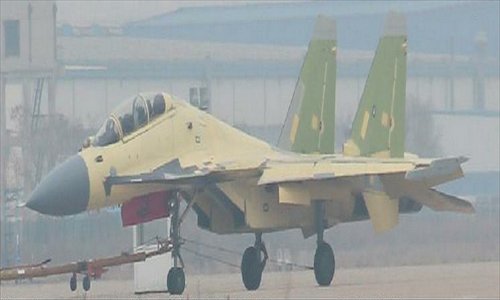Flight tests on China’s air carrier confirmed by Ministry of Defense

Military authorities confirmed Sunday that carrier-based jets have been conducting take-off and landing training on the country's first aircraft carrier Liaoning.
According to an official report released by the Ministry of Defense, jets have practiced touch-and-go landings, a maneuver that involves landing on the flight deck of the carrier and taking off again without coming to a stop.
It is the first time Chinese authorities have acknowledged that jet pilots have been training on the Liaoning.
Online photos from unofficial sources have shown that the Shenyang J-15 carrier-based fighter has made at least several fly-bys above the carrier and military experts have long speculated that touch-and-go landings are being practiced by pilots.
Lan Yun, editor of the Beijing-based Modern Ships magazine, said touch-and-go landings are the last step in primary training for carrier-based fighter pilots.
"In real operations, if pilots judge they cannot complete a landing, they must immediately open full afterburner and takeoff from the flight deck again," Lan said, "The touch-and-go landings enable the pilots to experience the feeling of a carrier landing and takeoff, and train them to properly handle failed landings," he said.
A Chinese naval expert told the People's Daily Online on October 19 that touch-and-go exercises enable pilots to overcome fear factors.
Actual carrier landings and take-offs might take place within months, Lan predicted, adding that combat capability will only be achieved after pilots can properly coordinate and carry out different tactical missions.
Monday's ministry announcement came a day after photos of a two-seat land/sea attack variant of the J-15 carrier-based fighter, also developed by the Shenyang Aircraft Corporation (SAC), were uploaded to the Internet.
Web users also claimed the two-seat fighter made its maiden flight at Shenyang on Saturday, two days after the maiden flight of SAC's first stealth fighter which outsiders call the "J-31." Major military news outlets reposted the photos immediately.
If the maiden flight of the two-seat variant turns out of be true, it means a boost for the potential strike ability of China's future carrier-based jet fleet, Lan said, noting that two-seat variant is more suitable for ground attack missions.
Rear Admiral Yin Zhuo said in an interview with the China Central Television that the Chinese navy will focus on the development of aircraft carriers and carrier-based fighters, new destroyers and frigates, submarines and land-based strike fighters.